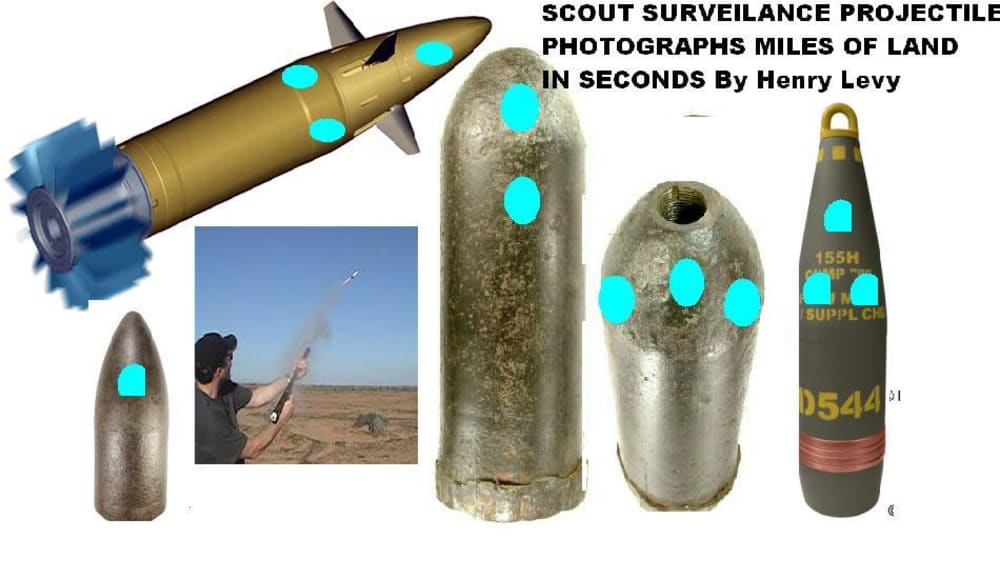This new gun fired or rocket launched scout surveilance bullet / projectile photographs miles of land in seconds while radio transmiting its colored imagery to a remote radio receiver, computer, amd display. This scout surveillance projectile is comprised of a casing, high speed camera image sensors (with lenses), battery, radio transmitter, time clock, GPS receiver, inertial switch, inertial accelerometer, gravitational sensor, and a computer.
The scout projectile can be the diameter of a bullet, mortar round, rocket propelled grenade, artillery round, or bazooka projectile.
The scout surveillance projectile is either shot like a bullet from a shell containing gun powder and a percussion ignition means or it is rocket propelled. In other configurations, the projectile can alternatively be (1) gun fired by carbon dioxide bursts, (2) propelled like a mortar, a rocket propelled grenade, or bazooka, (3) shot like an artillary round, (4) electromagnetically launched (5) fired as an electrically ignited rocket bullet, (6) or even launched like a parachute rocket flare projectile, but with pop-out wings and stabilizer which multiplies the length of flight time and distance. All electronic components are very high G-force shock resistant linearly and centrifugally. Surface mounted electronic components (SMT) can be high G-force resistant as in GPS steerable smart artillery projectiles. Some surveillance projectiles contain explosive charges and some launching barrels have rifling, but some don't. When the projectile is fired, the latching inertial electrical power switch connects the battery power to all projectile electronic components. The optics consist of a forward looking fisheye lens and multiple wide aperture lenses arranged cylindrically around the projectile’s exterior. Lenses are recessed from the barrel’s rifling. Image sensors are positioned behind the lenses so that scenery imagery can be focused through the lenses onto the image sensors. The computer receives and integrates input from all sensors. Image sensor imagery data is input into the computer which transmits it to the radio transmitter.
The cameras may be visible or infrared light sensitive. The cameras may be high-resolution line scanners or rectangular pixel sensitive arrays. Image data will be time marked along with GPS flight data. The image data transmitted by the projectile’s radio transmitter is received by a remote radio receiver. The imagery has to be unscrambled, unraveled, decoded, and interpreted, because the images came from spinning or tumbling bullet/projectiles. The data may be immediately replayed and reviewed slowly as a series of images or video stream. The remote radio receiver of projectile imagery data takes received data and sends it to a computer that processes it to make it viewable on a display for a policeman, fireman, soldier, or astronaut.
A soldier using this still image and/or video scout bullet could use it to see rivers and mountains ahead or to see advancing troops and tanks. An astronaut using a CO2 launched scout bullet, can see terrain over hills, craters, and mountains while plotting his course. A ship or howitzer can fire larger observation projectiles more than 20 miles. The Hellarewe Tribe could have used this.
Like this entry?
-
About the Entrant
- Name:Henry Levy
- Type of entry:individual
- Software used for this entry:MSPAINT
- Patent status:none

